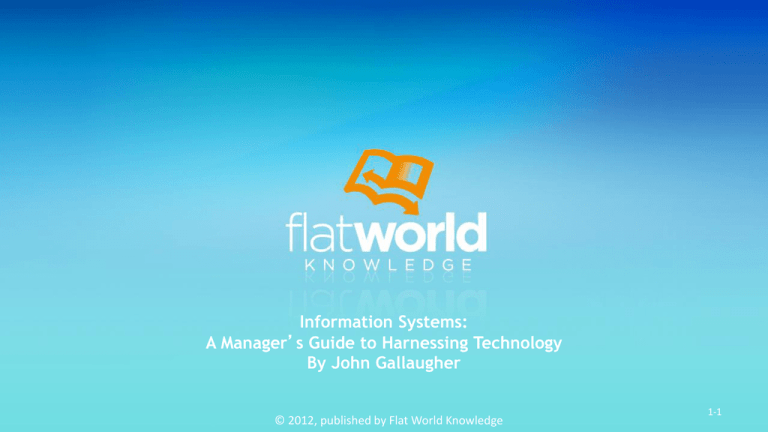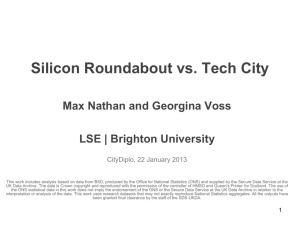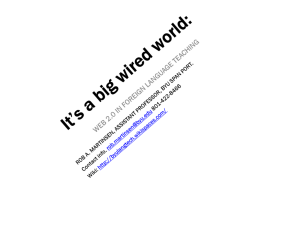Slide
advertisement

Information Systems: A Manager’s Guide to Harnessing Technology By John Gallaugher © 2012, published by Flat World Knowledge 1-1 This work is licensed under the Creative Commons Attribution-Noncommercial-Share Alike 3.0 Unported License. To view a copy of this license, visit http://creativecommons.org/licenses/by-nc-sa/3.0/or send a letter to Creative Commons, 171 Second Street, Suite 300, San Francisco, California, 94105, USA © 2012, published by Flat World Knowledge 1-2 Chapter 1 Setting the Stage: Technology and the Modern Enterprise © 2012, published by Flat World Knowledge 1-3 Learning Objectives • Appreciate how in recent years, technology has helped bring about radical changes across industries and throughout societies • Name firms across hardware, software, and Internet businesses that were founded by people in their twenties (or younger) © 2012, published by Flat World Knowledge 1-4 Learning Objectives • Appreciate the degree to which technology has permeated every management discipline • See that tech careers are varied, richly rewarding, and poised for continued growth Understand the structure of this text, the issues and examples that will be introduced, and why they are important • © 2012, published by Flat World Knowledge 1-5 Tech’s Tectonic Shift: Radically Changing Business Landscapes • Billions of people have access to computing and telecommunications • Google and Facebook have changed the way firms advertise and people communicate • Open source software has lowered computing costs © 2012, published by Flat World Knowledge 1-6 Tech’s Tectonic Shift: Radically Changing Business Landscapes • Sophisticated, high-powered computing is turning into a utility via: – Cloud computing – Software as a service • New technologies have also: – Fueled globalization – Redefined concepts of software and computing – Crushed costs – Fueled data-driven decision making – Raised privacy and security concerns © 2012, published by Flat World Knowledge 1-7 It’s Your Revolution • Many of the world’s most successful technology firms were created by young people – Bill Gates was an undergraduate when he left college to found Microsoft – Michael Dell was a sophomore when he began building computers at the University of Texas – Mark Zuckerberg founded Facebook as a nineteen-year-old college sophomore © 2012, published by Flat World Knowledge 1-8 It’s Your Revolution – Tony Hsieh of LinkExchange and Zappos – Jerry Yang and David Filo of Yahoo! – Steve Chen and Chad Hurley of YouTube – Steve Jobs of Apple – Jeff Bezos of Amazon – Catherine Cook of MyYearbook – Shawn Fanning of Napster – Linus Torvalds – Linux operating system – Sergey Brin and Larry Page of Google © 2012, published by Flat World Knowledge 1-9 Geek Up—Tech Is Everywhere and You’ll Need It to Thrive • There isn’t a single modern managerial discipline that isn’t being deeply and profoundly impacted by tech • Tech skills are becoming more important for jobs everywhere © 2012, published by Flat World Knowledge 1-10 Finance • The tech industry continually sprouts new businesses – Suited to IPO markets • Tech firms are actively involved in mergers and acquisitions (M&A) • Finance careers also involve: – Lending to tech firms – Evaluating the role of technology in firms in an investment portfolio • Technology-based trading platforms © 2012, published by Flat World Knowledge 1-11 Table 1.2 - 2011 Tech Deals by Sector © 2012, published by Flat World Knowledge 1-12 Accounting • The reliability of any audit is inherently tied to the reliability of the underlying technology • Increased regulation has strengthened the link between accounting and tech – Sarbanes-Oxley Act • Major accounting firms have spawned tech-focused consulting practices © 2012, published by Flat World Knowledge 1-13 Marketing • Firms are shifting spending from traditional media to the Web because of its ability to: – Track customers – Analyze campaign results – Modify tactics © 2012, published by Flat World Knowledge 1-14 Marketing • Firms are using social media to: – Generate sales – Improve their reputations – Better serve customers – Innovate © 2012, published by Flat World Knowledge 1-15 Marketing • Central components of the new marketing toolkit include: – Search engine marketing (SEM) – Search engine optimization (SEO) – Customer relationship management (CRM) – Personalization systems – Managing the balance between gathering data and respecting consumer privacy © 2012, published by Flat World Knowledge 1-16 Operations • Tech-centric operations include: – Quality programs – Process redesign – Supply chain management – Factory automation – Service operations © 2012, published by Flat World Knowledge 1-17 Human Resources • Knowledge management systems are morphing into social media technologies • Technology is used for employee training, screening, and evaluation • Recruiting has moved online – Grounded in information systems that scour databases for specific skill sets – Job seekers are writing resumes with key words in mind • Professional social networks have put added pressure on employee satisfaction and retention © 2012, published by Flat World Knowledge 1-18 The Law • Activity has increased in the areas of intellectual property, patents, piracy, and privacy • Firms need legal teams with the skills to: – Determine whether a firm can legally do what it plans – Uncover licensing fees if patents stand in the way – Help them protect proprietary methods and content – Help enforce claims in the home country and abroad © 2012, published by Flat World Knowledge 1-19 Information Systems Careers • Programmers • Experts in user-interface design, process design, and strategy • Consulting and field engineering • Chief information officer • Chief technology officer • “C-level” specialties in emerging areas – Chief information security officer (CISO) – Chief privacy officer (CPO) © 2012, published by Flat World Knowledge 1-20 Your Future • Study business and technology to develop critical-thinking skills – To help in the evaluation of new, emerging technologies • Those not trained to evaluate and make decisions risk irrelevance, marginalization, and failure © 2012, published by Flat World Knowledge 1-21 The Pages Ahead • Chapter 2 - Strategy and Technology: Concepts and Frameworks for Understanding What Separates Winners from Losers • Chapter 3 – Zara: Fast Fashion from Savvy Systems • Chapter 4 - Netflix in Two Acts: The Making of an E-commerce Giant and the Uncertain Future of Atoms to Bits • Chapter 5 - Moore’s Law: Fast, Cheap Computing and What It Means for the Manager • Chapter 6 – Understanding Network Effects • Chapter 7 - Social Media, Peer Production, and Web 2.0 • Chapter 8 - Facebook: Building a Business from the Social Graph © 2012, published by Flat World Knowledge 1-22 The Pages Ahead • Chapter 9 – Understanding Software: A Primer for Managers • Chapter 10 – Software in Flux: Partly Cloudy and Sometimes Free • Chapter 11- The Data Asset: Databases, Business Intelligence, and Competitive Advantage • Chapter 12 – A Manager’s Guide to the Internet and Telecommunications • Chapter 13 - Information Security: Barbarians at the Gateway (and Just About Everywhere Else) • Chapter 14 - Google in Three Parts: Search, Online Advertising, and Beyond © 2012, published by Flat World Knowledge 1-23






